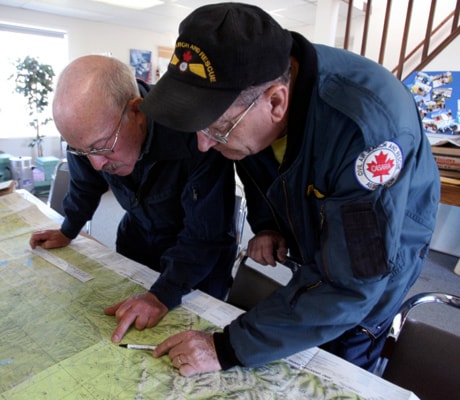Dressed in blue flight suits and blue jackets with Civil Air Search and Rescue Association patches on the side, around 20 volunteers prepare for a search.
Maps are splayed out over tables at the Red Deer Flying Club by the Red Deer Regional Airport on Saturday as navigators plot their courses with the search coordinates they’ve been given, pilots hear about the winds out of Calgary and Edmonton and about some wetter weather that could hit later in the day and spotters find out what they should be looking for on the ground — in this case something red.
Although it has all the makings of a real search this is just a practice run — something the CASARA volunteers do the first Saturday of the month to keep their skills fresh for when a real search is necessary.
The group invited media to the session, with it being National Search and Rescue Day on Saturday.
The volunteer group, which receives funding from the Canadian Forces to cover expenses, is primarily tasked with finding downed aircraft, but the CASARA volunteers have also assisted in searches for missing children, Alzheimer’s patients and even oilfield workers lost in the bush. They are assigned by the Canadian Forces through the 435 Transport and Rescue Squadron out of Winnipeg and the Joint Rescue Co-ordination Centre, but can also be asked to help by the RCMP or other official organizations.
Each team of volunteers is made up of a pilot, often flying a Cessna 182 or a similar-sized plane, along with a navigator and two spotters — one on the left and one on the right side of the aircraft.
Red Deer resident Bert Lougheed, a retired school principal, has been involved as a search and rescue volunteer for more than 30 years and has been with CASARA since it started in 1985. “Some people golf, but I fly,” he said.
He served as a CASARA pilot for 19 years and he still pilots a communications aircraft, relaying information from one plane to another that are outside of communications range from one another. He also now acts as a chief spotter, training the new recruits how to find what they’re looking for from the air.
“The first thing I tell the spotters is to look for anything that is unusual in the environment,” Lougheed said. It can be a matter of seeing tree tops snapped off where a plane has crashed through them or seeing singed red trees where a plane on fire has set nearby forest alight. It can also involve looking for a gathering of scavenging animals, including bears, crows or coyotes.
Lougheed said when people act as spotters it’s not just a matter of looking out the window, but the search is done systematically with the individual scanning from left to right focusing on a patch of ground about the size of their hand and then moving on to a new patch, as they scan across the land.
Carissa Tuck is one of the new spotters with the group. Her father Russ McCord, who has been involved with CASARA for five years, encouraged her to join and it’s a way for the two to bond. When she isn’t volunteering with CASARA she is looking after her seven-month old daughter Coral-Lee and doing dog and cat grooming at her home in Innisfail. Tuck said she enjoys volunteering with CASARA because she likes the idea of being able to find people and she enjoys getting up in the plane.
“Everybody is really accepting and they really want to help you train,” said Tuck, who will need to get up in the plane three times before she can be certified as a spotter and be involved in a real search.
There are a variety of different ways they can search including a sector search, which entails searching out from one main point in a pie shape, or the expanding square, which has a plane spiral out from a specific point in a square shape. They can also do mountain contours, which entails circling a mountain and then dropping down lower and circling again, over and over until the pilot gets to the bottom, as well as other search patterns.
On Saturday, CASARA pilot Jim Thoreson, was going to be searching the North Saskatchewan River from Rocky Mountain House to the Brazeau Dam and then doing mountain contours, circling a mountain in a counter clockwise motion. Thoreson has been involved with the group for the past 18 years and flies a Cessna 182.
“I enjoy the work,” Thoreson said. “I love flying and when you find somebody it’s a good feeling. Even if people haven’t survived it’s closure for the family.”
CASARA can also work with ground searchers, relaying photographs from the air of the terrain to help them get a better picture of the hazards and dangers they may face or an easy access point into the area.
Wes Cooke, of Morningside, was the search co-ordinator for the simulated search exercise on Saturday. He has been with CASARA for 10 years, getting involved through the Red Deer Flying Club. “I believe in what we are doing. There is a need,” said Cooke, who is a private pilot, but not certified to fly with CASARA.
He encouraged other people to try volunteering with CASARA, saying they don’t need to be pilots or have flying experience and can even work on the ground volunteering if it makes them more comfortable.
Anyone wanting more information can go to the website www.casaraalberta.ca or contact Randi at sargirl67@hotmail.com.
sobrien@www.reddeeradvocate.com
